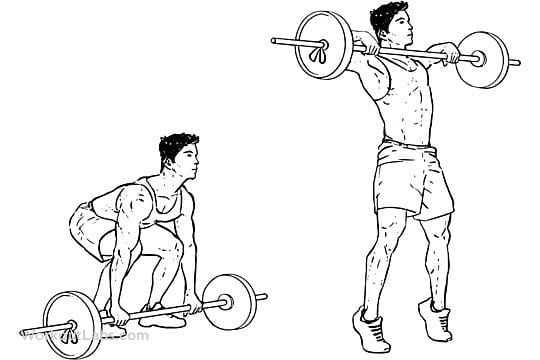By the healthiergang writer , student in Physiotherapy.
High Pull
The high pull is an exercise with many benefits. Some of these are:
- allows you to work a lot of muscles throughout the body, both in the upper and lower part.
- allows you to work on the explosive component of the movement, a factor that is often not considered but of great use
- it is a kind of multi-joint exercise which allows you to effectively stimulate the lateral and rear deltoid, the medium and low trapezius and the rhomboid. This is an advantage to consider because these muscles tend to lack adequate development
The high pull can be assimilated to a variant of the "Upright Row" (pulled to the chin) but without the stress on the joints that this movement provides.
Stress is significantly reduced as movement is assisted, if not performed for the most part, by an explosive extension of the pelvis. This allows you to remove a great deal of stress in a very risky position or with an intra-rotated shoulder.
How is it done?
- The execution of the high pull provides that the bar is held with an opening equal to or slightly greater than that of the width of the shoulders.
- From this position the pelvis is brought back, loading the buttocks and hamstrings and slightly flexing the knees.
- The pelvis must be brought back until the bar reaches knee level. Bringing the pelvis backwards, the torso tilts forward, the inclination reached depends on the particular morphological proportions but generally is around 45 degrees.
- From this position contract explosively buttocks and hamstrings and at the same time fully extend the knees.
- During this step the pelvis must be brought forward quickly and the torso must return to a vertical position if not inclined slightly further.
- When the pelvis reaches the bar, start the movement with the arms bringing the bar up, always keeping the elbows close to the body. using the thrust of the lower part, the arms and shoulders must bring the bar up to eye level or chin.
- At this point, check the descent of the barbell trying to resist with his shoulders.
Since the weight used should be significantly higher than what you can move, the only aim is to maintain a controlled eccentric phase. when the bar returns to pelvis the repetition is over. At each repetition repeat the process previously described.

Mistakes To Avoid
If this exercise is not performed correctly, there is a risk of putting the shoulder under severe stress.
It is therefore important focus on retracting the shoulder blades as upper limb movement begins and hold them in that position until the bar returns to the Hang position.
It is also important keep your hands higher than your elbows. The hands must always be kept above the elbows because otherwise the shoulder is brought into an internal rotation that jeopardizes the integrity of its ligaments.
The first half of the barbell pull is a kind of side lift with bent arms.
When the elbows come about to be parallel to the ground, continue the movement with an external rotation of the shoulder, that is, bringing the hands upwards.
To maximize the work of the lateral delts, it is helpful to focus on bringing the elbows outwards.
This allows you to perform an abduction of the shoulder in the best possible way and therefore to stimulate the central deltoid in the best possible way.
The greatest stimulus occurs in the negative phase n when this muscle is subjected to a load greater than what it is able to move.
Also in this portion of the movement you have to try to push your elbows outward. The second phase of pulling is accompanied by an extension of the thoracic spine. This allows to relieve stress from the shoulder joint and at the same time helps the extra-rotation movement and maintenance of the position of the shoulder blades.
Series And Reps
Since high pull is an explosive and quite technical exercise, the repetitions will necessarily be medium-low. A high number of repetitions per set would lead to an inevitable deterioration of the technique. Good guesses could be:
- 4 or 6 sets of 4-6 repetitions with a minute and a half or two minutes of recovery
- 3 or 4 sets of 6-8 repetitions with a minute or so of recovery
The high pull can be inserted up to 3 times a week in your routine, always focusing on correct execution and loads consistent with one's abilities.


























